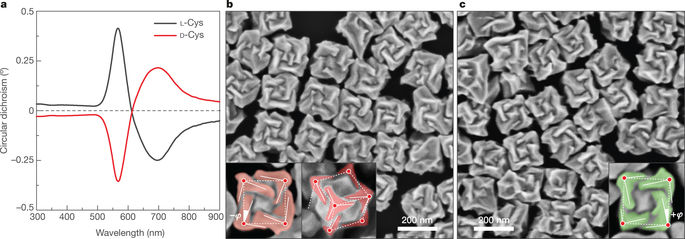Our official English website, www.x-mol.net, welcomes your
feedback! (Note: you will need to create a separate account there.)
Amino-acid- and peptide-directed synthesis of chiral plasmonic gold nanoparticles
Nature ( IF 50.5 ) Pub Date : 2018-04-01 , DOI: 10.1038/s41586-018-0034-1 Hye-Eun Lee , Hyo-Yong Ahn , Jungho Mun , Yoon Young Lee , Minkyung Kim , Nam Heon Cho , Kiseok Chang , Wook Sung Kim , Junsuk Rho , Ki Tae Nam
Nature ( IF 50.5 ) Pub Date : 2018-04-01 , DOI: 10.1038/s41586-018-0034-1 Hye-Eun Lee , Hyo-Yong Ahn , Jungho Mun , Yoon Young Lee , Minkyung Kim , Nam Heon Cho , Kiseok Chang , Wook Sung Kim , Junsuk Rho , Ki Tae Nam

|
Understanding chirality, or handedness, in molecules is important because of the enantioselectivity that is observed in many biochemical reactions1, and because of the recent development of chiral metamaterials with exceptional light-manipulating capabilities, such as polarization control2–4, a negative refractive index5 and chiral sensing6. Chiral nanostructures have been produced using nanofabrication techniques such as lithography7 and molecular self-assembly8–11, but large-scale and simple fabrication methods for three-dimensional chiral structures remain a challenge. In this regard, chirality transfer represents a simpler and more efficient method for controlling chiral morphology12–18. Although a few studies18,19 have described the transfer of molecular chirality into micrometre-sized helical ceramic crystals, this technique has yet to be implemented for metal nanoparticles with sizes of hundreds of nanometres. Here we develop a strategy for synthesizing chiral gold nanoparticles that involves using amino acids and peptides to control the optical activity, handedness and chiral plasmonic resonance of the nanoparticles. The key requirement for achieving such chiral structures is the formation of high-Miller-index surfaces ({hkl}, h ≠ k ≠ l ≠ 0) that are intrinsically chiral, owing to the presence of ‘kink’ sites20–22 in the nanoparticles during growth. The presence of chiral components at the inorganic surface of the nanoparticles and in the amino acids and peptides results in enantioselective interactions at the interface between these elements; these interactions lead to asymmetric evolution of the nanoparticles and the formation of helicoid morphologies that consist of highly twisted chiral elements. The gold nanoparticles that we grow display strong chiral plasmonic optical activity (a dis-symmetry factor of 0.2), even when dispersed randomly in solution; this observation is supported by theoretical calculations and direct visualizations of macroscopic colour transformations. We anticipate that our strategy will aid in the rational design and fabrication of three-dimensional chiral nanostructures for use in plasmonic metamaterial applications.Chirality can be ‘encoded’ into gold nanoparticles by introducing chiral amino acids or peptides during the growth process, leading to the formation of helicoid morphologies.
中文翻译:

手性等离子体金纳米粒子的氨基酸和肽导向合成
了解分子中的手性或手性很重要,因为在许多生化反应中观察到了对映选择性 1,并且由于最近开发的具有特殊光操纵能力的手性超材料,例如偏振控制 2-4、负折射率 5 和6. 手性感应 手性纳米结构已经使用纳米制造技术如光刻 7 和分子自组装 8-11 生产,但 3 维手性结构的大规模和简单制造方法仍然是一个挑战。在这方面,手性转移代表了一种更简单、更有效的控制手性形态的方法12-18。尽管一些研究 18,19 描述了分子手性转移到微米级螺旋陶瓷晶体中,该技术尚未应用于数百纳米尺寸的金属纳米颗粒。在这里,我们开发了一种合成手性金纳米粒子的策略,该策略涉及使用氨基酸和肽来控制纳米粒子的光学活性、手性和手性等离子体共振。实现这种手性结构的关键要求是形成高米勒指数表面({hkl},h ≠ k ≠ l ≠ 0),由于纳米颗粒中存在“扭结”位点20-22,这些表面本质上是手性的在成长过程中。纳米粒子的无机表面以及氨基酸和肽中手性组分的存在导致这些元素之间的界面处的对映选择性相互作用;这些相互作用导致纳米粒子的不对称演化以及由高度扭曲的手性元素组成的螺旋形形态的形成。我们生长的金纳米粒子显示出很强的手性等离子体光学活性(不对称因子为 0.2),即使在溶液中随机分散时也是如此;这一观察得到了理论计算和宏观颜色变换的直接可视化的支持。我们预计我们的策略将有助于合理设计和制造用于等离子体超材料应用的三维手性纳米结构。通过在生长过程中引入手性氨基酸或肽,手性可以“编码”到金纳米粒子中,导致螺旋形态的形成。我们生长的金纳米粒子显示出很强的手性等离子体光学活性(不对称因子为 0.2),即使在溶液中随机分散时也是如此;这一观察得到了理论计算和宏观颜色变换的直接可视化的支持。我们预计我们的策略将有助于合理设计和制造用于等离子体超材料应用的三维手性纳米结构。通过在生长过程中引入手性氨基酸或肽,手性可以“编码”到金纳米粒子中,导致螺旋形态的形成。我们生长的金纳米粒子显示出很强的手性等离子体光学活性(不对称因子为 0.2),即使在溶液中随机分散时也是如此;这一观察得到了理论计算和宏观颜色变换的直接可视化的支持。我们预计我们的策略将有助于合理设计和制造用于等离子体超材料应用的三维手性纳米结构。通过在生长过程中引入手性氨基酸或肽,手性可以“编码”到金纳米粒子中,从而导致螺旋形态的形成。这一观察得到了理论计算和宏观颜色变换的直接可视化的支持。我们预计我们的策略将有助于合理设计和制造用于等离子体超材料应用的三维手性纳米结构。通过在生长过程中引入手性氨基酸或肽,手性可以“编码”到金纳米粒子中,导致螺旋形态的形成。这一观察得到了理论计算和宏观颜色变换的直接可视化的支持。我们预计我们的策略将有助于合理设计和制造用于等离子体超材料应用的三维手性纳米结构。通过在生长过程中引入手性氨基酸或肽,手性可以“编码”到金纳米粒子中,导致螺旋形态的形成。
更新日期:2018-04-01
中文翻译:

手性等离子体金纳米粒子的氨基酸和肽导向合成
了解分子中的手性或手性很重要,因为在许多生化反应中观察到了对映选择性 1,并且由于最近开发的具有特殊光操纵能力的手性超材料,例如偏振控制 2-4、负折射率 5 和6. 手性感应 手性纳米结构已经使用纳米制造技术如光刻 7 和分子自组装 8-11 生产,但 3 维手性结构的大规模和简单制造方法仍然是一个挑战。在这方面,手性转移代表了一种更简单、更有效的控制手性形态的方法12-18。尽管一些研究 18,19 描述了分子手性转移到微米级螺旋陶瓷晶体中,该技术尚未应用于数百纳米尺寸的金属纳米颗粒。在这里,我们开发了一种合成手性金纳米粒子的策略,该策略涉及使用氨基酸和肽来控制纳米粒子的光学活性、手性和手性等离子体共振。实现这种手性结构的关键要求是形成高米勒指数表面({hkl},h ≠ k ≠ l ≠ 0),由于纳米颗粒中存在“扭结”位点20-22,这些表面本质上是手性的在成长过程中。纳米粒子的无机表面以及氨基酸和肽中手性组分的存在导致这些元素之间的界面处的对映选择性相互作用;这些相互作用导致纳米粒子的不对称演化以及由高度扭曲的手性元素组成的螺旋形形态的形成。我们生长的金纳米粒子显示出很强的手性等离子体光学活性(不对称因子为 0.2),即使在溶液中随机分散时也是如此;这一观察得到了理论计算和宏观颜色变换的直接可视化的支持。我们预计我们的策略将有助于合理设计和制造用于等离子体超材料应用的三维手性纳米结构。通过在生长过程中引入手性氨基酸或肽,手性可以“编码”到金纳米粒子中,导致螺旋形态的形成。我们生长的金纳米粒子显示出很强的手性等离子体光学活性(不对称因子为 0.2),即使在溶液中随机分散时也是如此;这一观察得到了理论计算和宏观颜色变换的直接可视化的支持。我们预计我们的策略将有助于合理设计和制造用于等离子体超材料应用的三维手性纳米结构。通过在生长过程中引入手性氨基酸或肽,手性可以“编码”到金纳米粒子中,导致螺旋形态的形成。我们生长的金纳米粒子显示出很强的手性等离子体光学活性(不对称因子为 0.2),即使在溶液中随机分散时也是如此;这一观察得到了理论计算和宏观颜色变换的直接可视化的支持。我们预计我们的策略将有助于合理设计和制造用于等离子体超材料应用的三维手性纳米结构。通过在生长过程中引入手性氨基酸或肽,手性可以“编码”到金纳米粒子中,从而导致螺旋形态的形成。这一观察得到了理论计算和宏观颜色变换的直接可视化的支持。我们预计我们的策略将有助于合理设计和制造用于等离子体超材料应用的三维手性纳米结构。通过在生长过程中引入手性氨基酸或肽,手性可以“编码”到金纳米粒子中,导致螺旋形态的形成。这一观察得到了理论计算和宏观颜色变换的直接可视化的支持。我们预计我们的策略将有助于合理设计和制造用于等离子体超材料应用的三维手性纳米结构。通过在生长过程中引入手性氨基酸或肽,手性可以“编码”到金纳米粒子中,导致螺旋形态的形成。









































 京公网安备 11010802027423号
京公网安备 11010802027423号